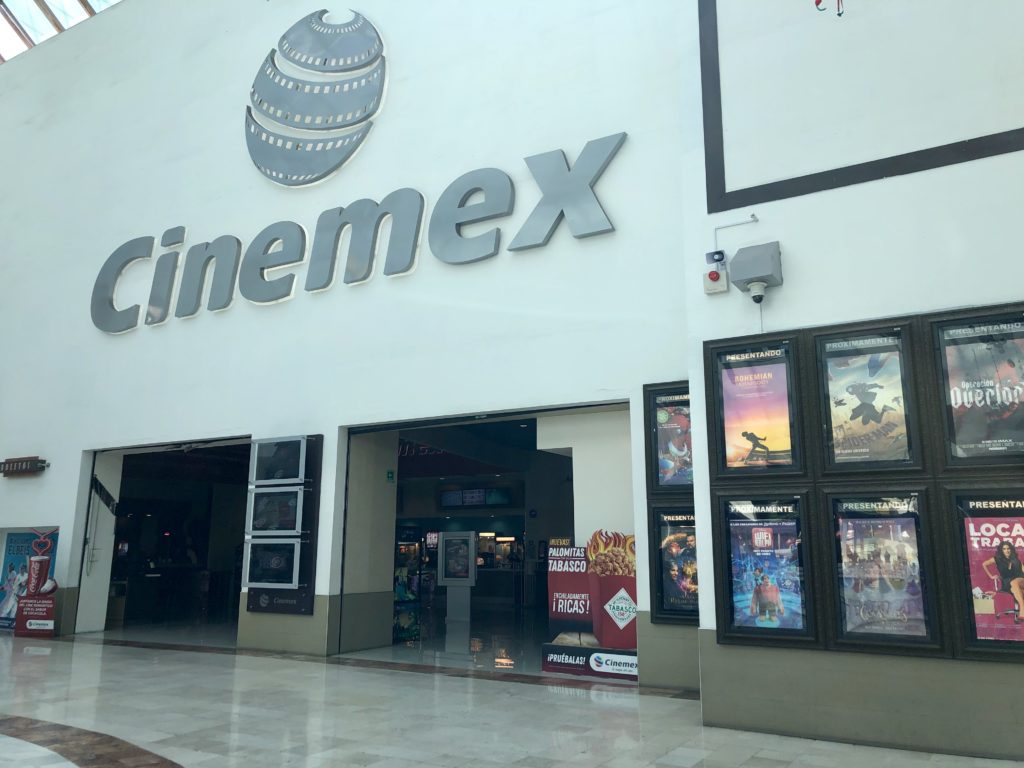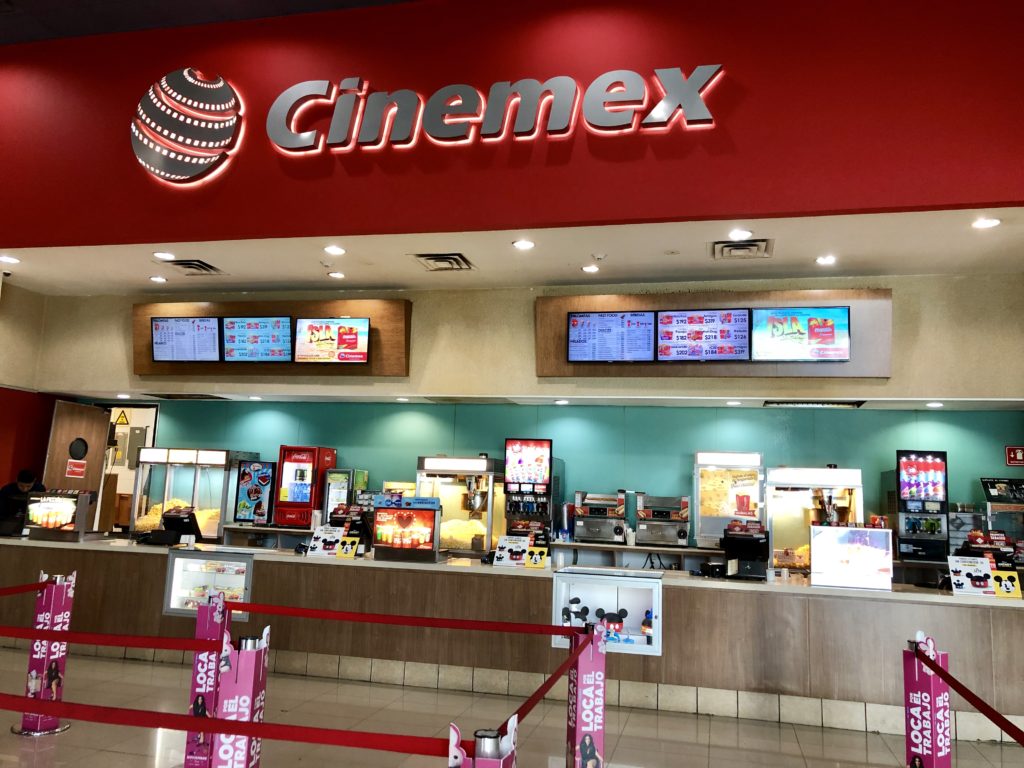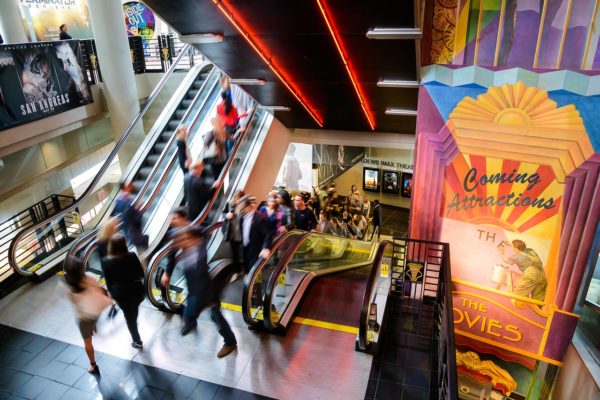Theaters aren’t just a place to watch movies–they’re also a place to form relationships, spend time with family, or just escape from the world for a few hours. With the bulk of movie theaters worldwide currently shutdown, the staff of Boxoffice Pro reflects on the theaters that helped foster their love of film.
Kevin Lally, Executive Editor
Clairidge Theatre [now Bow Tie Clairidge Cinemas] and Wellmont Theatre | Montclair, NJ
Fox Theatre and Oritani Theatre | Hackensack, NJ
Growing up in Bergen County, New Jersey, one of the most densely populated counties in the nation, I never realized how good I had it as a young moviegoer. It was a short bus ride to New York City’s Radio City Music Hall, the fabled art deco entertainment showplace where your ticket often got you both a movie and a stage show. (My first movie there: That Darn Cat!, starring Hayley Mills and Dean Jones.)
But Bergen County also had its own wonderful movie palaces. In those days of exclusive roadshow engagements that could last for months, even a year, the movie mecca was Montclair, New Jersey, with its two huge movie palaces, the Claridge and the Wellmont, both opened in 1922. It was in Montclair—a half-hour drive from my hometown of Dumont—that I saw the Oscar-winning musicals My Fair Lady and The Sound of Music before they finally branched out to more towns. Today, the Wellmont is a live performance venue, and the Claridge is a six-plex operated by Bow Tie Cinemas.
The next tier down in my area of Bergen County was Hackensack. That town with the odd name boasted not one but two bona fide movie palaces, the Fox and the Oritani, right across from each other on Main Street. Named for a local Indian chief, the Oritani opened on May 6, 1926 with a double bill of Lady Windermere’s Fan and Nobody’s Business, according to the invaluable website Cinema Treasures. Five years later, the art deco Fox debuted with Jackie Coogan in Huckleberry Finn. The Fox held more than 2,200 seats, the Oritani 1,800, and both were beautiful, ornate temples from a bygone age. I saw many movies there—the most indelible is watching Stanley Kramer’s all-star comedy extravaganza It’s a Mad, Mad, Mad, Mad World on the Oritani’s huge screen at age 11 and laughing so hysterically at the brutal fire escape climax my parents almost took me out of the theater.
Sadly, these two New Jersey gems are no more. According to Cinema Treasures, the Fox’s last first-run film was Jaws 2 in 1980 and it was torn down in 1998. The Oritani’s auditorium was demolished in 1985.
My hometown, Dumont, did not have its own movie theater. The closest was in neighboring Bergenfield: the Palace, which seemed an inapt name after enjoying the wonders of the Fox and the Oritani. There I saw many a Disney cartoon and live-action comedy. In retrospect, the onetime Spanish Baroque vaudeville house probably was a palace by current standards: Today it’s a five-screen theater, formerly owned by Bow Tie Cinemas and now independently operated.
Daniel Loría, Editorial Director
Cinemark 12 Plaza Boulevares [Today: Cinemex Boulevares Queretaro] | Queretaro, Mexico

The first multiplex opened in my hometown in 1996. There must have been less than a handful of twin cinemas operating in Queretaro before Cinemark opened that multiplex; a brand new 12-screen facility, one of their first outside of the United States.
That movie theater changed something in the city. Our soccer team was either out of business or in the second division back then, and there wasn’t much else to do. And everything about that theater was unique and innovative at the time, from the lobby to the concessions stand and auditoriums––it was the only cinema in town that didn’t have intermissions. I’d go with my friends mid-week (2-for-1 admissions) and with my family over the weekend. Sometimes I’d end up seeing the same movie twice in the same week.
The first movie I saw there was Dracula, Dead and Loving It, starring Leslie Nielsen. I also remember watching That Thing You Do with a friend who later started his own band in middle school; Jack and thinking it was so bad that the rest of the director’s movies probably sucked, too; buying a commemorative cup for Independence Day on opening night; Mars Attacks, Mission: Impossible, The Rock, the Star Wars theatrical re-issues…I must have seen every studio title exported to Mexico between the summers of ‘96 and ‘97 in that theater. I’d ride my bike to the newsstand by my house and buy the latest issues of Cine Premiere and Cinemanía to find out about the coming releases. Most of my romance with moviegoing came from that theater.

The multiplex opened around the same time that Carrefour unveiled the city’s first large-scale supermarket; I was 11 years old, and all of a sudden you saw foreign companies investing in Queretaro and introducing these modern retail concepts. There’s this great novella, “Las Batallas en el Desierto” by José Emilio Pacheco, that touches on this theme of a rapidly changing Mexico that is modernizing and how that brings a simultaneous sense of excitement and nostalgic anxiety. We moved out of Queretaro in the fall of 1997. Every time I return the city looks less familiar, likely because I can’t help but remember it the way it was during our last year living there.
Despite all the changes to the city, that movie theater is still there. Cinemark sold its Mexico locations to Cinemex back in 2012, and while the branding is different a lot of the structural details remain. When my parents moved back to Queretaro, they moved to a house six blocks from the cinema. I still visit it every time I walk past, not to see a movie but mostly to reassure myself it’s still there. On a recent trip, a security guard spotted me taking some pictures of the lobby and sternly asked what I was doing. I couldn’t come up with a succinct explanation.
Rebecca Pahle, Deputy Editor
Palace Stadium 12 and Movies at the Lake | Cornelius, NC
For the last 12 years of my life, I’ve lived in New York. It’s a city with no shortage of movie theaters, even though they all happen to be closed for the moment. When the Covid crisis is over, I know that I—along with many, many other people—will count going to the movies among my very first activities. I may not know what movies will be playing whenever the marquees light back up, but I’m already dreaming of the concessions I’m going to get. The thought of popcorn at the IFC Center, tater tots and cheese at the Nitehawk, and a boozy milkshake at Alamo Drafthouse’s Brooklyn location is getting me through some tough times. (Look, I never claimed “healthy” among the attributes I look for in movie theater concessions.)
Before I lived in New York, I grew up in Charlotte, North Carolina—first the city itself and then, from middle school through college, in the town of Cornelius, about 20 minutes north. The fondest moviegoing memories from my childhood are tied to details of the theatrical experience. At seven, feeling scandalized when my Aunt snuck Burger King Whoppers into the theater when she took us to see Hook. At eight, getting to Aladdin so close to showtime that my family and I had to sit in the front row, but being so transfixed by the movie that I didn’t even notice the crick in my neck. Lining up for midnight screenings of Star Wars and Lord of the Rings, the excitement I felt in my stomach very real but not quite enough to keep me from gobbling down popcorn.
The theaters I went to were typical suburban multiplexes of the closing years of the 20th century. They didn’t have premium large-format screens, recliners, or dine-in menus. They weren’t particularly “special,” looking back. One of them had a party room that I hardly saw anyone use; another may have had a claw machine. But they felt special to me. They gave me a treat, a solace, a way to bond with my family. They introduced me to my love of movies and set me on the career path I’m on today.
They are also, for the most part, closed. The first theater that felt like it was truly mine was called Movies at the Lake. It opened its doors, and a shopping center built up around it—now, that area is bustling and built-up, but Movies at the Lake isn’t there. It closed in 2004 and became a NASCAR store (hey, North Carolina). Then there was The Palace, which, for a reason I was never quite able to figure out was decorated to look like an Egyptian temple. It closed suddenly after three years and stood abandoned for over a decade until a church moved in. (They did not keep the decorations.) Movies at Birkdale—now Regal’s Birkdale Stadium 16—opened when I was a junior in high school, just in time for me to see Moulin Rouge there four times. (Musical geeks c. the early 2000s know what’s up.)
Traveling back home from New York to see my family, I would make a point of going back to Birkdale if I could. Christmas afternoon, in particular, was a designated movie time for the Pahle household. But driving past Movies at the Lake and the Palace always made me sad. Their familiar facades said “movie theater,” but they lacked the magic that had made them so much more than mere buildings. When we lose theaters, we don’t just lose bricks and metal. We don’t just lose movies. You lose memory, spirit, and family. You lose a second home.
Jesse Rifkin, Analyst
AMC Georgetown 14 | Washington D.C.
I perform every Friday and Saturday night at a piano bar in the Georgetown area of Washington, D.C. Only a few hundred feet away is the AMC Georgetown, where I attend a movie almost every Friday or Saturday night, two or three hours before my gig. Since it’s located in one of the nicer areas of the nation’s capital, there’s always the possibility of running into a major political figure. There was always a small but possible chance I might run into Dick Cheney when I saw Vice there, or Ruth Bader Ginsburg when I saw On the Basis of Sex. I mean, I didn’t. But there was still the chance.
Chris Eggertsen, Analyst
Century 8 [Today: Cinemark’s Century Stadium 16] | Mountain View, CA
I grew up in Ventura, California, about an hour north of LA. Many of my most formative moviegoing experiences were at the Century 8 (later the Century Stadium 16), a pink palace of a multiplex that has since shut down and been taken over by a church (!). I worked there over the summer between my junior and senior years of high school and spent many long nights scooping popcorn into bags, pulling questionable items out of cupholders, and being accosted by customers who were livid over the concession prices. Oh, what I wouldn’t do to have those days back!
Shawn Robbins, Chief Analyst
My earliest days of moviegoing took place at Carmike’s Highland in Cookeville, Tennessee, which grew from four to ten to twelve screens during various phases as I grew up. It’s the theater my father took me to as a kid, and the one my friends and I congregated at regularly throughout high school and college, creating the foundation for my obsession with cinema. Having lived closer to Nashville for over a decade now, I tend to consider the AMC Thoroughbred in Franklin my home base. My wife and I will venture out to other Nashville-area venues, like Regal’s Opry Mills location, to check out its largest-in-the-area Imax screen or meet family and friends, but I’ve seen more films at the Thoroughbred than anywhere else. Their Dolby Cinema auditorium provides one of the flat-out best theatrical experiences in this part of the country.
Share your own hometown theater memories with the hashtag #MoviesTogether, or let us know about them here.



Share this post